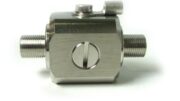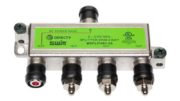Sounds like something this robot would say. But it’s actually a very important part of digital broadcasting, in fact one of the most important ways we measure how well or poorly a signal is actually received.
It’s a simple concept
Bit error rate (BER, if you’re in a hurry) is simply a measure of how much of a signal comes in clear and strong and how much doesn’t. A high bit error rate means the signal will eventually break up and a low bit error rate means that you’ll see what you want to see. It’s easy to understand, but the first thing you need to know is that all digital broadcasting has error correcting built in and you need to understand a little bit of how it works.
How bit error rate works
Imagine I said to you, “3+rrrfsaqqqxx=6.” That part in the middle is an error, but you know that I’m asking you to add two numbers, one of them is 3 and the total is 6. So, presuming that you’re older than first grade age, you know the other one is also 3. That’s a form of error correction. Another form of error correction is more “cognitive” and involves you understanding a little bit of what I’m trying to do ahead to time. If I said, Thr blnd mc, thr blnd mc, s hw th rn” you would still figure out what I was saying, because you know I’m singing a nursery rhyme and you know what the missing letters are supposed to be.
Digital broadcasts use both these methods and several other ones to deal with the errors that come with broadcasting. That’s part of the reason that digital broadcast signals can get through when analog ones can’t; it’s not that they’re stronger, but they’re built to be corrected when errors come in.
Eventually, the errors take over and the processing equipment inside the receiver can’t deal with it. I mean, if all you got from that nursery rhyme was “Thr blsss eedddqsqut xxttlin fubb” you’re not going to know what it is. Believe it or not bit error rates can get pretty high before the processing chips give up but eventually they do. When that happens, you lose picture and sound. Simple as that.
The real story about amplifiers and bit error rate
Amplifying a signal doesn’t generally improve bit error rate and sometimes has a negative effect on signal to noise ratio. That’s the reason why amplification isn’t as important as it used to be for digital broadcasting. Amplifying only improves the strength of the signal itself. Amplifying the signal is important when distributing to multiple TVs or over long runs, but it does not help create signals when signals don’t exist. That said, a good high-quality amplifier will at least not be harmful and could help bring in very marginal signals, allowing processing equipment to have a better chance at decoding them.
Get the right amplifier from Solid Signal
Solid Signal has a wide variety of signal amplifiers for virtually any need. Shop the great selection at SolidSignal.com for amplifiers and all the other equipment you’ll need to live your best digital life. Do you have questions? Call us during East Coast business hours at 888-233-7563 and we’ll help!




